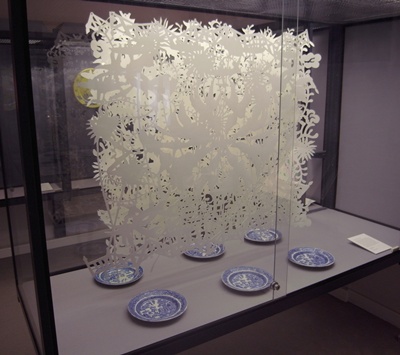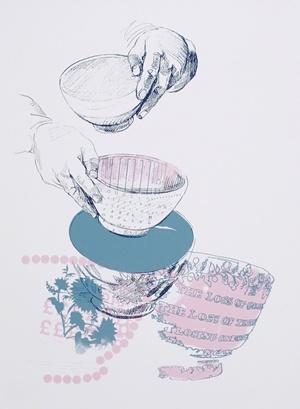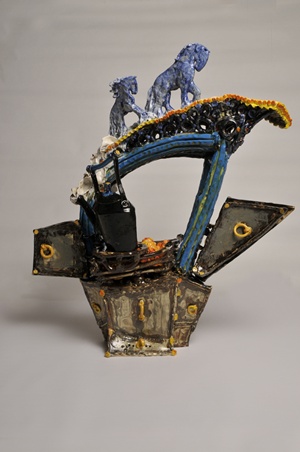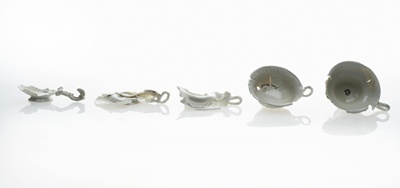Memory and Function
An exhibition of ceramics and found artefacts
22 January - 01 March 2010
19.03.10
Artefacts from the Ceredigion Museum Collection, Aberystwyth University Ceramic Collection and from participating artists’ personal possessions were exhibited alongside original artworks. Artists included: Claire Curneen, Conor Wilson, Anne Gibbs, Peter Bodenham, Ingrid Murphy, Andy Griffiths, Catherine Fairgrieve, David Fitzjohn, Erica Evans, Paul Roche, Kerry Harker, Zoe Childerley and Robert Harding amongst others.
Cradling a cup of tea and chatting about times past and present is such a part of our everyday lives. Cath Roche, ceramicist, painter and curator brought together a group of contemporary ceramicists who respond to how strongly memories are associated with domestic objects in an exhibition entitled “Gathered World”. Historic objects, mostly selected from displays at Ceredigion Museum Aberystwyth, were shown alongside the contemporary works of each maker. These have personal associations for each of the exhibiting artists.
The exhibition at the ceramic gallery of Aberystwyth University, housed at the Aberystwyth Art Centre, was displayed in what now seems a rather tired space. It is time maybe for a revamp but this does not detract from the quality of curatorship.
My eye was drawn immediately to David Fitzjohns’ paper cut, dramatically lit and beautifully intriguing. It is based on the meanderings around a fantasy world created from the delicate patterning found in willow pattern plates left empty after Sunday lunch. Forced to sit quietly after the meal his mind would wander into the scene found before him. His paper sculpture floats above a set of six willow patterned plates set ready for a meal, hovering like a lace memory.

David Fitzjohn Sunday Lunch © David Fitzjohn
Catherine Fairgrieve also works with paper and is inspired by historic ceramic objects which are decorated with transfer prints, mainly of poetry. Pink lustre jugs and bowls covered in words of love and longing stand chipped and scratched on handmade paper. Swirling repeated words and flying objects, wooden spoons mixing ingredients and memories suggest the use and re-use of the vessels.

Catherine Fairgrieve Ceramic Poems (detail) © Catherine Fairgrieve
This show was about the function of the object but also about the stories associated with each object. Conor Wilson shows an old fine china slip-ware cup decorated with a typical rose decoration complete with gold rim, but alongside he has placed his own hand-created cup similar in shape but with a vicious thorn handle and the gold rim has slipped inside suggesting a tea stain, conveying both an unusual tactility and the suggestion of a memory.
.jpg)
Conor Wilson Made in England (50 Hours) © Conor Wilson
Robert Harding presents us with a phallic and sadistic-looking screw- encrusted ceramic shower head. His label tells of the torture of being forced to endure cold showers at school. This object left me to reflect on my own youthful nightmares.
Cath Roche herself goes for a much more academic, museum approach in her personal display and brings together a series of decorative cups and saucers to which she has attached hand-written labels. While both informative and amusing I felt that this part of the exhibition would have benefitted visually from having a much greater number of exhibits in the space, suggesting the endless number of tea-break conversations in our society and the obsession with documentation and cataloguing which we now seem to have.
Domestic tasks and work generally are reflected in the pieces presented by artists Andy Griffiths and Peter Bodenham. Griffiths shows a small metal bowl made by the artist which stands next to an old glass butter churn. We can see the rhythm and physical effort of stirring and turning via a small looped film screened next to the bowl. Here sparks like fireworks fly wildly out in a cascade of action suggesting the energy which goes into making.
Bodenham has chosen an historic earthenware milk cooler as inspiration for his elegant, thrown series of “Polar” containers. They are each crowned with a found decorative ceramic figurine. These figures have been glazed with a silver lustre removing them from our world, conveying a sense of timelessness. Each cooler sits on an old plate, again suggesting a recycled memory, a looking to the past for a new way of living.
Lost and faded memories also make an appearance in the show. Ingrid Murphy captures a story of her childhood hope for an imaginary parcel coming from America in her beautiful ceramic piece. Two cups of gold liquid spill a memory of a sinking ship suggesting the loss of the parcel on its journey.
.jpg)
Ingrid Murphy Parcel From America © Ingrid Murphy
Paul Roche, in his usual exuberant way, depicts in clay a magical transformation ̶̶ a black kettle balanced on the edge of a grate pumping out swirls of steam which form into two heaving cart horses.

Paul Roche Eaglesbush Tin Works © Paul Roche
Movement and transformation also work for Geng Xue in her piece “The other side”. Here we find small clay figures swimming as though through and into another dimension, another universe. In sharp contrast Claire Curneen has a mother and child stand firm and still, hands and faces dipped into thick gold lustre suggesting the richness conveyed in the passing of knowledge and love. Like the Staffordshire flat-back historic figures of a cow and calf which sit alongside her piece we are led to contemplate mammalian relationships and the passing of time.
.jpg)
Geng Xue The Other Side © Geng Xue
Perhaps the most poignant pieces in the display are the photographic image by Zoe Childerley and the cup series by Erica Evans. Both of these pieces continued to provoke thoughts well after I left the gallery.
Zoe Childerley’s photograph of a highly decorative cup and saucer sit alongside the real cup and saucer. In the picture we see an old gnarled hand holding the cup forward as though presenting it to us. The image of the person is blurred leaving us to ask why we are being shown this cup. What can we tell from this photograph?
In contrast the message is clear in the work of Erica Evans. A series of slip-cast cups hangs on a row of hooks, each progressively diminished in form, suggesting deterioration. This is based on her experience of losing her mother to dementia.

Erica Evans No Time To Stop For Tea © Erica Evans
This is an engaging exhibition with many layers of significance. It appeals to me as an historian, artist, curator, and lover of objects old and new. It is particularly interesting to see a range of contemporary art works relating to historic objects being displayed in a ceramic gallery. This exhibition questions our understanding of the past and the present, and the function and meaning of objects.
Stuart Evans